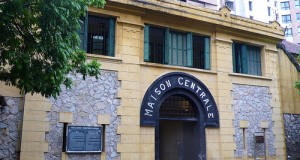 Not only represent the sovereignty of Vietnam, the flag towers are also the highlights in the urban landscape architecture today. Along the country, there are several famous FlagTowers.
Not only represent the sovereignty of Vietnam, the flag towers are also the highlights in the urban landscape architecture today. Along the country, there are several famous FlagTowers.
1. Hanoi Flag Tower
Located on Dien Bien Phu Street (Ba Dinh District, Hanoi),Hanoi Flag Tower is one of the symbols of the capital, a part of the Hanoi Citadel and a World Heritage Site. It was built in 1982. Unlike many other structures in Hanoi, this flag tower was not destroyed during the French administration (1896-1897) and being used as a military post. Now, it is locating in Vietnam Military History Museum.
Hanoi Flag Tower is composed of three platforms and a tower with a spiral staircase leading to the top inside it. The first tier is 42.5m wide and 3.1m high. The second tier is 25m wide and 3.7m high and it has four doors. On the eastern door, there are two words “Nghenh Huc” – meaning “to welcome dawn’s sunlight”. The western door has the two words “Hoi Quang” – meaning “to reflect light”, and the southern door bears “Huong Minh” – meaning “directed to the sunlight”. The third tier is 12.8m wide and 5.1 high. The tower tower is lighted by 36 flower-shaped and 6 fan-shaped windows. The National Flag of Vietnam is on top of the tower.


Hanoi Flag Tower at night
2. Lung Cu Flagpole
Lung Cu flag tower, approximately 170km from Ha Giang town and about 24km from the centre of Dong Van district, is becoming one of the most meaningful destinations for tourists in Ha Giang province. Situated in the Lung Cu peak (or Dragon Mount), the National Flagpole Lung Cu has a height of 1,700m above the sea level. From its top, visitors can see the whole of beautiful and spectacular landscape.
Lung Cu flagpole has a very long history and was restored several times. The last restoration and inaugurate was on September 25th, 2010. The new flagpole has a total height of 33.15 meters. Its design is an imitation of theHanoiFlagTower, with eight bronze drums guarding the sides of the octagonal tower. The national flag adorning the top of the 135-stair tower has an area of 54m², symbolizing the unity ofVietnam’s 54 ethnic groups.

Lung Cu flagpole is located in Lung Cu peak


3. Thanh Nam Flag Tower (the South flagpole)
Thanh Nam flag tower is located in Nam Dinh province. The flagpole was built of old, dark red bricks and it attaches with many important historical events. The flagpole was built in the 11th Gia Long (1812) – at the same time with Hanoi one, and until 1843 it was completed. The flagpole was recognized as the state-level site by Department of culture and information on April 28, 1962. The flagpole with nearly two-century history has witnessed many changes in the country and homeland.
The flagpole is 23.84m high and it was built on two bases, square columns. On the second floor, four sides are built handrail, sculpted four-door. On the east-door, there are two words “Nghenh Huc” (to welcome dawn’s sunlight) and on the southern door, there are two words “Huong Quang” (light-driven). The body of flagpole has a height of 12.65m with two parts: The lower bowl of adjacent cylinders, each side 2.20m, above the base circle diameter of 3.25m. From the southern door, there is away to get into the flag pole with 54 stairs.

4. Hue flag tower
Flag Tower Hue is the work of the architectural complex ofHueancient capital, located in front of Ngo Mon Gate. It is the focal point ofHuecity. It is commonly known as a flagpole, but viewed from the Imperial City, it is really a huge structure of three flat-top pyramids, one lying on top of another.
The flag tower was built in 1807 during Emperor Gia Long’s reign and later improved by his son, Emperor Minh Mang. The flag-tower is 17.40m high and consists of three terraces. The first is 5.60m high, the second 5.8m, and the third 6m. On the third terrace, there are 8 little buildings housing and two sentry-boxes at opposite ends. The 29.52m flag-staff was originally made of wood. It was replaced by a new one in 1846 by Emperor Thieu Tri and again in 1914, with French assistance, with a cast-iron one after having been destroyed by a typhoon. Forty-three years later, after the return of the French colonialists (1947), the staff was again destroyed. So it was in 1948 that a 21 m concrete staff was erected.


– www.vietnamtravelinformation.net –
 Vietnam Travel Guide Backpacking and Individual Travel Blog
Vietnam Travel Guide Backpacking and Individual Travel Blog







